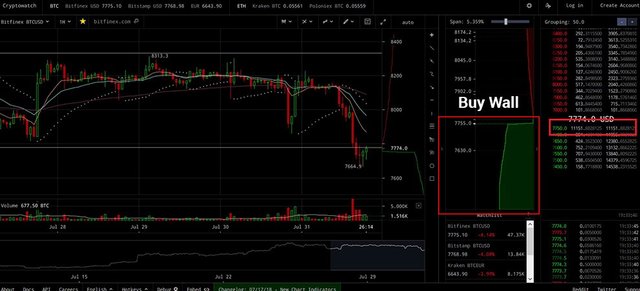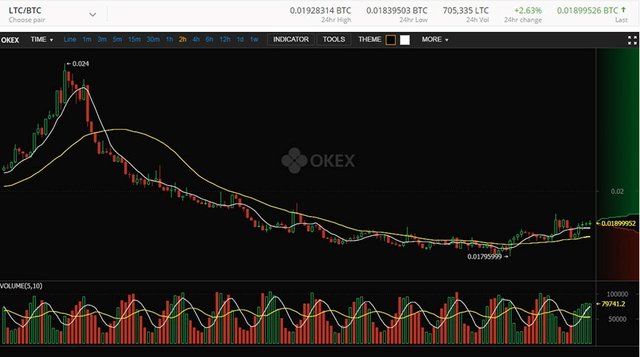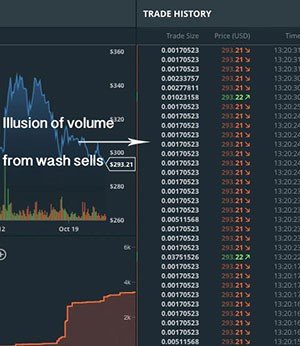Crypto Spoofing & Washing: How Whales are Eating Your Lunch "*MUST READ*"

When it comes to the cryptocurrency markets, there are two tactics that the whales have been using with killer effects over the past year.
These are order spoofing and Wash trading. These tactics are methods of market manipulation that they have been using to reap outsized returns. These returns have all come at the expense of the retail cryptocurrency trader who fell for the dirty tricks.
In this post, we will take an in depth look at these tactics by analysing previous episodes of crypto spoofing and wash trading. We will also give you information about how to spot these attempts and avoid falling victim.
Before we get onto that, let us start with some of the basics…
What is Order Spoofing?
Quite simply, order spoofing is a form of market manipulation where an individual will create a host of fake orders with no intention of ever having them executed. This is done in order to create a certain perception around where the market is heading.
The individual who is doing the spoofing is hoping that this market sentiment will impact on the price of the asset in question. They will usually have a position in the asset that will benefit from a movement in the price.
Order spoofing is actually a tactic that has been outlawed by the SEC and has been actively prosecuted in the past. However, when it comes to the still unregulated and anonymous cryptocurrency markets, things are not as easy as they seem.
Sometimes order spoofing is combined with other tactics such as stop loss hunting where the trader will try identify where stop orders have been placed.
What is Wash Trading?
Wash trading is the practice of faking volume. This is done by a trader or a group of traders buying and selling their own orders for a particular coin. It gives the market the perception that there is interest in a coin when there isn’t really.
It is also sometimes practiced by shady exchanges in order to create the perception that a great deal of trading is taking place. This will dupe potential retail traders into using the exchange.
Just like order spoofing, this has been outlawed in traditional financial markets since the passage of the Commodity Exchange Act (CEA) in 1936. Wash trading is also very hard to get away with in traditional financial markets as the exchanges have a number of built in protections to avoid it.
Now that we have an understanding of the basics of the manipulation, let’s take a look at some examples in practice.
Spoofing and Washing in the Wild
You may have come across Bitcoin order spoofing before. You would have observed a large buy or sell wall in an exchanges order books that would have appeared and disappeared seemingly out of nowhere. This is the trader placing and removing the order at the chosen times.
For example, if you take a look at the below order books from the Bitifinex exchange a few weeks ago. You can see a massive buy wall with a large order of slightly more than 11,000 BTC at a price of $7,750.

Recent Buy Wall with Large Order. Image source: Cryptowatch
If you were a cryptocurrency trader who was just observing the order books as an indication of market sentiment, you may perceive this a bullish indicator. It will lead you to buy Bitcoin in anticipation of a rally.
Many other traders will follow in your footsteps and the price will rally in response to it. However, what you do not know is that the Whale that has placed this order actually has a long position in Bitcoin and is looking for buyers where he can offload his position at a profit.
The moment that the whale has secured a certain amount of profit from his spoofing endeavours, he will pull the orders from the book. Consequently, that solid buy wall will disappear in front of your eyes. Below is another image from the Bitfinex order books from late last year.

Buy wall disappears from Order Books. Image source: Bitfinex’ed
On the left is the order books attempting to create an illusion of a Bitcoin buy wall with a large order at $8,900 for 502BTC. However, on the right is the exact same order book a mere 5 minutes later. As you can see, the massive buy wall has just evaporated.
It’s likely that the person who had placed that 502BTC order had no intention of it ever getting executed. In this case, the trader realised that their spoof was not convincing the market and decided to remove their orders.
How would this effect you?
Well, if you thought that this was a bullish sign of movement you could have placed a buy order at $8,899. This would have been executed but you would also have noticed that the market had in fact retreated. The expected bullish sentiment was nothing but a fake.
Now lets take a look at an example of some wash trading.
This is a practice that exchanges can easily manage given the amount of funds that they have on their books. In the below image we have a well-researched example of some wash trading on the OKex exchange for LTC / BTC. Notice anything weird?

OKex Volumes on LTC/BTC Pairs. Image source: Sylvain Ribes
As you can see from the volume, the one thing that immediately sticks out is regularity of it. The volume goes through regular peaks and troughs throughout the day. It is highly unlikely that this is as the result of manual market flows through the books of OKEX.
All one need do is take a look at the LTC order books of another large exchange such as Poloniex or Bitstamp and you will see no such volume irregularities.
When fake volume is created, it makes the market think that there is activity in a coin or exchange when there is really none at all. There have also been other exchanges which have more recently been accused of these tactics.
How to Avoid Falling Victim
When it comes to order spoofing, there are generally quite a few things you can do in order to determine where the activity is taking place and how to spot it.
Firstly, before deciding on an exchange to trade with, you study their market statistics with tools such as cryptowatch. Here, you can take a look at all the exchanges and monitor their books in order to spot irregularities.
What you will be looking for are the large buy / sell walls that are often present on exchanges. If these walls have appeared at a time when there is not that much market news or movement, then it should already have piqued your interest.
What you will then want to do is monitor that buy / sell wall with a particular interest on the large order at the top of the wall (closest to market rates). If this order is pulled quickly after it has been formed then it is likely to have been a spoof and an attempt to manipulate the markets.
When it comes to washing, you should always be cautious when you observe high volume on an exchange that you have not heard a great deal about. This is especially true for those newer exchanges that have only been operating for a few months.
However, if you wanted to be able to spot wash trading as it happens, you will usually see a host of rapid executions at a stable price for a particular coin. Below is an example of some washed trades that were placed in an order book. As you can see, there was a whole host of “wash sells” that were placed at a price of $293.

Numerous washed sell orders on exchange. Image source: Cryptocurrency Facts
If you have observed these in the order books it should have raised suspicion that you could be witnessing a large wash trade.
An Ongoing Challenge
Although these tactics are able to help you by identifying suspicious activity, the malicious traders are also evolving. Nowadays most of the spoofing and wash trading is done with advanced high frequency trading bots.
These bots make use of the high through-put API connections on multiple exchanges in order to move markets more quickly than a manual trader. These trading bots have also previously been identified and given unique and interesting names such as the “Picasso trading bot“.
There is reason to be hopeful though.
The authorities are now quite aware of these tactics and are actively getting involved with enforcement. In fact, the US DOJ has recently released a criminal probe into the market manipulation practices on cryptocurrency exchanges.
As these opaque exchanges face more regulatory scrutiny, they are likely to adapt their procedures to actively stamp out the practice. They could also borrow a number of oversight mechanisms that are currently being used on stock exchanges for example.
Conclusion
Cryptocurrencies have taken off quicker than the traditional financial system and regulators have been able to adapt. While that has led to reams of innovation, it has also meant that malicious actors could take advantage of the lack of oversight.
Order spoofing and wash trading are those market manipulation tactics that are being employed in these “Wild West” markets. Although there are moves afoot to stamp these out, the tactics are evolving and innovating just like the underlying technology.
In the end, only you can really protect yourself from this manipulation. As long as you are aware of what to look for and which exchanges to avoid, you can prevent yourself from being a crypto whale’s “lunch”.
source:hacked.com
@shoulouder Just started following you
Thanks for giving such a good information
Pls follow @important-to-us
Congratulations @shoutlouder! You have completed the following achievement on Steemit and have been rewarded with new badge(s) :
Click on the badge to view your Board of Honor.
If you no longer want to receive notifications, reply to this comment with the word
STOP